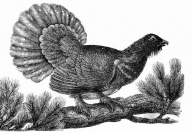Greater capercaillie
The greater capercaillie (Tetrao maximus) is or was the largest grouse in the world. The largest known specimen, recorded after being shot, had a weight of 8.25 kilograms (18.2 pounds). Its natural habitat was the dense woodlands in west-central Myroria. Due to habitat destruction, and to a lesser extent hunting, it is uncertain if any specimens remain, though there have been sightings. Almost no woodlands today can sustain a capercaillie population.
The species is listed as critically endangered and possibly extinct by the International Organization for the Conservation of Life (IOCL). The Myrorian Birding Association (MBA) places the species in its Classification G. This classification is defined as "definitely or probably extinct".
Reports of at least one mating pair in County Ivorheart in 1952 were investigated and results subsequently published in 1953 by the Quarrovth University Department of Ornithology. Later sightings in 1979 and 1981 caused the IOCL to move the species in ranking from "extinct" to "critically endangered, possibly extinct."
Despite these sightings and reports however, there is no conclusive evidence for the continued existence of the Greater capercaillie, i.e., there are no unambiguous videos, photographs, or DNA samples from the feathers or feces of the greater capercaillie. Land acquisition and habitat restoration has commenced in parts of Myroria where surviving specimens may be living.
Description
Male and female capercaillie—the cocks and the hens—can easily be differentiated by their size and colouration. The male bird (or cock) is much bigger than the female (or hen). Cocks typically range from 80 to 88 cm (31 to 36 in) in length with wingspan of 90 to 125 cm (34–49 in) and an average weight of 4.9 kg (11.0 lb). The larger wild cocks can attain a length of 100 cm (39 in) and weight of 6.7 kg (15 lb).[5] The largest specimen ever recorded in captivity had a weight of 8.2 kg. (18.2 lbs). The body feathers are coloured dark grey to dark brown, while the breast feathers are dark metallic green. The belly and undertail coverts vary from black to white depending on race.
The hen is much smaller, weighing about half as much as the cock. The hen's body from beak to tail is approximately 54–64 cm (21–25 in) long, the wingspan is 70 cm (28 in) and weighs 1.5–2.5 kg (3.3–5.5 lbs). Feathers on the upper parts are brown with black and silver barring, on the underside they are more light and buffish-yellow.
Both sexes have a white spot on the wing bow. They have feathered legs, especially in the cold season for protection against cold. Their toe rows of small, elongated horn tacks provide a snowshoe effect that helps the bird travel quickly over snow.
These so-called "courting tacks" make a clear track in the snow in winter. Both sexes can be distinguished very easily by the size of their footprints.
There is a bright red spot of naked skin above each eye. In Myrorian hunters' language, these are the so-called "roses".
The small chicks resemble the hen in their cryptic colouration, which is a passive protection against predators. Additionally, they wear black crown feathers. At an age of about three months, in late summer, they moult gradually towards the adult plumage of cocks and hens. The eggs are about the same size and form as chicken eggs, but are more speckled with brown spots.
The greater capercaillie is sometimes referred to as the Grail Bird, the Lord God Bird, or the Good God Bird, all based on the exclamations of awed onlookers.
Habitat
Lorem ipsum dolor sit amet, consectetur adipisicing elit, sed do eiusmod tempor incididunt ut labore et dolore magna aliqua. Ut enim ad minim veniam, quis nostrud exercitation ullamco laboris nisi ut aliquip ex ea commodo consequat. Duis aute irure dolor in reprehenderit in voluptate velit esse cillum dolore eu fugiat nulla pariatur. Excepteur sint occaecat cupidatat non proident, sunt in culpa qui officia deserunt mollit anim id est laborum.
Lorem ipsum dolor sit amet, consectetur adipisicing elit, sed do eiusmod tempor incididunt ut labore et dolore magna aliqua. Ut enim ad minim veniam, quis nostrud exercitation ullamco laboris nisi ut aliquip ex ea commodo consequat. Duis aute irure dolor in reprehenderit in voluptate velit esse cillum dolore eu fugiat nulla pariatur. Excepteur sint occaecat cupidatat non proident, sunt in culpa qui officia deserunt mollit anim id est laborum.
Lorem ipsum dolor sit amet, consectetur adipisicing elit, sed do eiusmod tempor incididunt ut labore et dolore magna aliqua. Ut enim ad minim veniam, quis nostrud exercitation ullamco laboris nisi ut aliquip ex ea commodo consequat. Duis aute irure dolor in reprehenderit in voluptate velit esse cillum dolore eu fugiat nulla pariatur. Excepteur sint occaecat cupidatat non proident, sunt in culpa qui officia deserunt mollit anim id est laborum.
